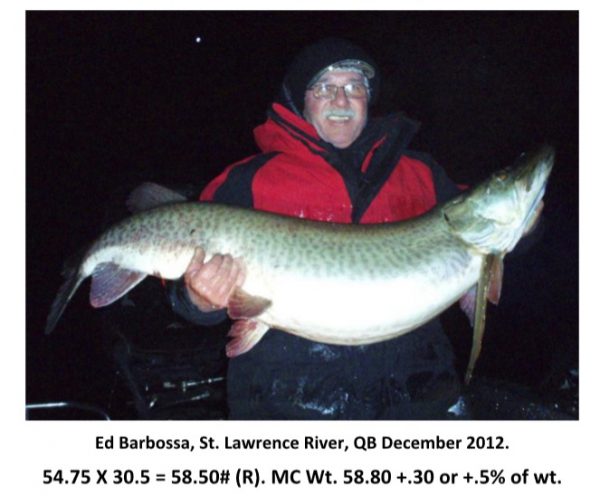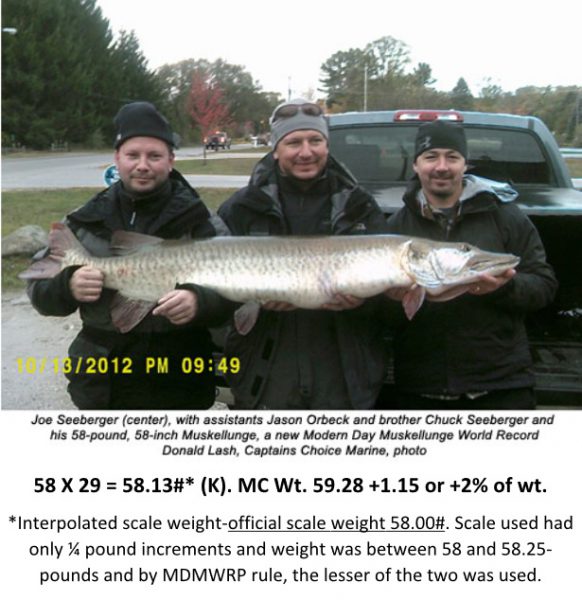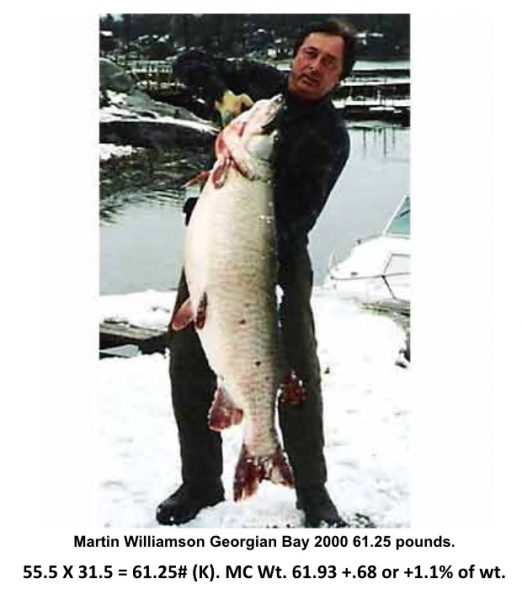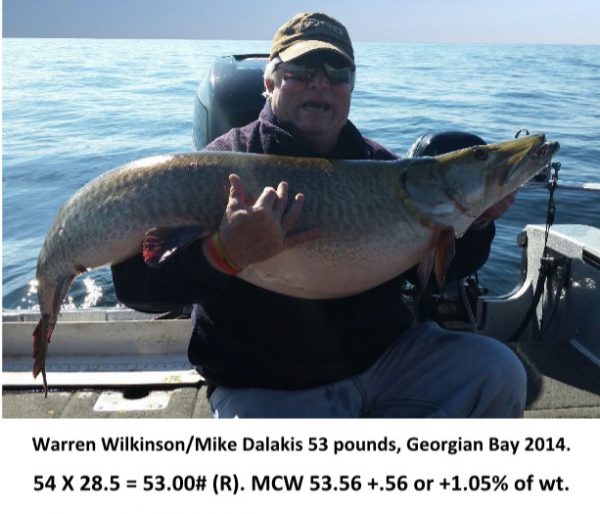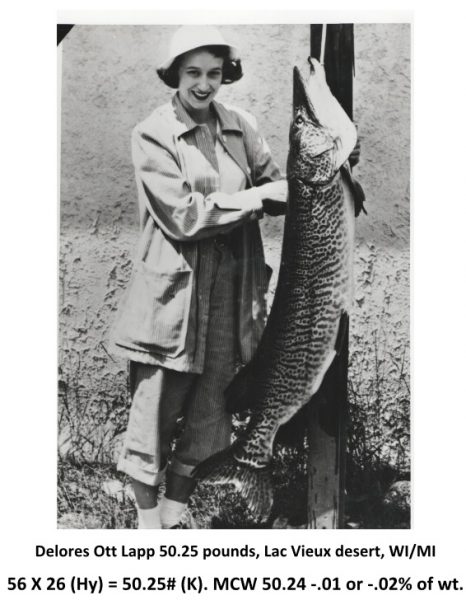New Formula For Estimating Released Muskellunge Weight
Category: article
Apr 13th, 2019 by sworrall
Modified Apr 13th, 2019 at 12:38 PM
The Modified Crawford Formula
For estimating the weight of the “Big Girls”
by Larry Ramsell (www.larryramsell.com)
For almost a century, mathematical formula has been used to attempt to estimate the weight of caught fish. The oldest known and still the most widely used by anglers, although it is not the best, is known as the “Standard Formula” (Length X Girth X Girth divided by 800) (L X G X G/800). It is believed that this formula was developed and has its earliest reference in the mid 1920’s by person or persons unknown. It was developed from measurements on dead salt water fishes. The International Game Fish Association (IGFA) still uses a derivative of this formula, albeit now using “fork length” rather than total tail length (FL X G X G/800), suggesting their agreement that the original formula was inaccurate. Both ways have been found to be “wanting” for use on muskies, both understating and overstating weight, sometimes in unacceptable amounts. And of course, anglers are reluctant to use a shorter fish length in calculating the weight of their musky!
Beginning in 1949, fisheries scientists have developed at least 20 different, formulas for estimating fish weight; several were musky specific. The problem with these formulae is the lack of knowledge of them and requirement of advanced math skills by the user, and in most cases, metric conversion requirements, rendering them unusable for the average U.S. angler. I recently had the newest/best and second-best fisheries scientist efforts converted to a form usable to me by Dr. Roy Crawford in order to apply them to the fish in this new formulas data base. While it appears that the newest fisheries formula may be the most consistent in fish up to 30 pounds over all, both were all over the board when applied to just muskies over 50-pounds and were nowhere close to the accuracy of this new Modified Crawford Formula. More on this shortly.
In addition to the Standard Formula and the IGFA fork length derivative, there are two other formulae developed by anglers, deemed usable in the past: First is a modified Standard Formula, aka the Wilkinson/Ramsell Formula (L X G-.75 X G-.75/800), developed for use on mid-sized (35 to 45-pounds) muskies to be released. This formula was found to be close to actual weights, but still somewhat lacking as it generally understated fish weight. It did, however, compensate for a bloated girth at capture, the reason for the formula modification in the first place, as several muskies thought to weigh 40-pounds from Georgian Bay, ON were kept, only to find out an hour or two later, on a scale, that the Standard Formula had overstated the muskies weight. This resulted in the muskies “premature” death and an unhappy angler. Now that almost total catch and release is the norm, this isn’t the problem that it was, and this formula is no longer applicable or necessary.
The second angler developed formula is the Crawford Formula (L X G/25 minus 10) presented in Musky Hunter magazine in 2002. This simple formula works best on muskies under 50-pounds, but again, it is merely an “estimate” of weight, but more importantly is simple to use.
There are a few other angler, manufacturer and magazine formulas out there besides those mentioned, but they are so far off on muskies as to be beyond reasonable consideration for use by musky anglers, especially the “big girls”.
After considerable Internet discussion in the fall of 2017, about creating a “World Record Release” category, I decided that I would attempt to develop a formula appropriate for just true giant muskies over 50-pounds. The result was this new formula and, a new World Record category founded for North American musky anglers use and can be found in the musky forum on the MuskieFirst.com website.
This newest formula, now known as the “Modified Crawford Formula” (MCF) (Length [in inches] X Girth [in inches] divided by 25 minus 8) (L X G/25-8), is used to “estimate” the weight of muskies over 50-pounds using length and girth measurements. It was developed by the author in 2017 from the base work of the Crawford Formula originally developed by Dr. Roy Crawford in 2002, with data on several hundred muskies, mostly in the small to mid-size range supplied by the author and Lax Taxidermy and published in Musky Hunter magazine. This new formula is derived from data only from muskies over 50-pounds and is, as is the original Crawford Formula, simplistic in its use (doesn’t take a math genius). More importantly, it is extremely accurate and consistent for use on muskies over 50 pounds weight, for which all previous formulas were found lacking consistency, were totally inapplicable or were extremely difficult to use and most were unknown to musky anglers.
Throughout the data base range of weights that were used to develop this new formula (27 muskies from 50 to 61.25-pounds), accuracy was maintained without greatly under or over stating actual fish weight, in this upper weight range of the species. This is of great value to musky anglers attempting to determine the estimated weight of a very large captured musky prior to release without the use of a scale.
A comment here about a previously mentioned “full (or bloated) swim bladder” affecting girth measurement should be discussed further, and it is indeed a concern for released fish. I know of one instance on the St. Lawrence River at Gananocque, Ontario, where a first live girth measurement was 28 inches and a very brief time later it was 26.25 inches!! The anglers observed the girth deflate! This phenomenon is more common in rivers with heavy current, muskies brought out of deep water or sadly and unnecessarily, dragged behind a moving boat while trolling! Overstating the girth measurement with any formula will adversely affect the result of the “estimated” fish weight, but this new formula will not be nearly as affected as will the “Standard Formula”, (L X G X G/800) that compounds the errant result with the double use of the inaccurate girth measurement.
As for my Modified Crawford Formula limited data base, I now have 27 samples that I have confidence in; 8 weighed released muskies over 50-pounds to 58.85-pounds that had total length and girth measured and weight taken on a certified scale, and 19 from 50-pounds to 61.25-pounds that were kept, measured and weight certified. This includes a few from history that are valid, and the others are from trusted sources.
The released category of this total data base fell into a maximum-minus of 1.47-pounds to a maximum-plus of 2.51-pounds MCF accuracy to actual weight, with an average of -1.47 and +1.24-pounds.
The kept category fell into a maximum minus of 2.57-pounds to a maximum plus of 2.35-pounds accuracy range to actual weight. The averages for the kept category were minus .94-pounds to plus 1.13-pounds. While both categories were close to actual weights, some differences in the maximum deviations were possibly due to different folks doing the measuring with unknown measuring devices in most cases, and different types of scales doing the actual weighing.
In comparing this new formula’s application on muskies over 50-pounds with the two best of the fisheries scientist formulas, as well as the Standard Formula, the new MCF was considerably more accurate. One fisheries formula had wild swings of plus 14.23-pounds and minus 6.52-pounds and the other had wild swings of plus 11.20-pounds and minus 8.51-pounds and the Standard Formula had two plus weights of 5 to more than 7.5-pounds plus, vs. the new MCF where mild weight deviations of only plus 2.51-pounds and minus 2.57-pounds for the 27 muskies over 50-pounds in this new formulas data base! Interestingly, the wildest swings in the two fisheries formulas were on the same two fish and the two extremely plus fish weights using the Standard Formula were both extremely girthy fish, which is common in fall giants.
After completing this exercise, it became obvious to both Dr. Crawford and me that these fisheries formulae were best applicable to the parameters of the weight of the muskies in the data bases that they were developed from to maintain fair accuracy. To quote Dr. Crawford: “…As I said before, ‘power’ fits (type of formula math that was used in the fisheries formulae-LR) can be useful, with the exception that they are often not good for extrapolation. So, I am guessing that these formulae fall apart for cases that are outside of the data that they used to develop them.”
I have data on several other muskies over 50-pounds throughout history, but lack confidence in the accuracy of the measurements, so they were not used. It should be noted here, that throughout musky angling history, muskies over 50-pounds have been extremely rare based on actual numbers of muskies captured every year and resulting reliable data even rarer. It should also be noted that very few scientific data bases include more than a miniscule number of muskies over 50- pounds, if any.
The total number of muskies now in this new data base were captured by anglers from early season (April-W.Va) throughout the summer to very late season (November and December) from all parts of the North American muskellunge range, including Ontario 10 (includes 4 shared border water fish with NY), Quebec 6, New York 4 (all shared border water fish with Ontario), Wisconsin 5 (including 1 shared border water fish), Minnesota 3, Michigan 2 (including 1 shared border water fish), and Iowa and West Virginia with one each. These total samples are from six states and two Canadian provinces. This gives a fair representative sample geographically and season wide. Some of these muskies may have been pre-spawn or immediate post-spawn and the very late season fish would/should have been building egg mass (although 2 kept fish had minimal egg development in late fall). This gives a quite varied, albeit limited, data base for this formula’s validity.
Also, as would/should be expected, most of these fish came from large, commonly known trophy musky water bodies, the big three being the St. Lawrence River, ON, QB & NY (6); the Ottawa River, QB (4) and Georgian Bay, ON (3) for a total of 13 of the 27. The other fourteen contributing water bodies provided only one fish each.
Many thanks to Dr. Roy Crawford and Kevin Richards, “Lunge Log” editor for Muskie magazine for their help and contributions. The fisheries formulas are the Meerbeek and Crane formula (Fisheries 1-published 2017; presented at the 2016 Muskie Symposium); and the Casselman and Crossman formula (Fisheries 2-published 1986; presented at the 1984 Muskie Symposium).
Data follows:
Calculation Comparisons of the Two Best Fisheries Scientist Formulas and the Standard Formula vs. The New “Modified Crawford Formula for Use on Muskies Over 50-Pounds
L & G MCF Fisheries 2 Fisheries 1 Std. Act. Wt.
1) 53 X 29 53.48 51.56 53.73 55.72 53.00
2) 54 X 28.5 53.56 54.32 56.66 54.83 53.00
3) 54.75 X 30.5 58.80 49.99 51.98 63.66 58.50
4) 59 X 27 55.72 60.18 62.80 53.76 55.56
5) 58 X 29 59.28 64.75 67.76 60.97 58.13
6) 55.5 X 31.5 61.93 56.50 58.96 68.84 61.25
7) 52.5 X 30.75 56.58 58.76 61.50 62.05 58.05
8) 57.5 X 27.75 55.83 64.70 67.73 55.35 53.50
9) 57.25 X 27 53.83 55.45 57.77 52.17 51.31
10) 55 X 28 53.60 50.31 52.32 53.90 52.20
11) 56 X 27.5 53.60 54.42 52.32 52.94 53.00
12) 53.5 X 28.5 52.99 50.95 53.06 54.32 55.56
13) 60 X 29 59.60 61.66 64.35 63.08 59.69
14) 55 X 29.63 58.19 55.77 58.19 60.36 56.44
15) 52 X 29 52.32 53.06 55.38 54.67 52.75
16) 54.5 X 27.5 51.95 55.04 57.42 51.52 52.31
17) 56 X 26 50.24 53.02 55.20 47.32 51.00
18) 56 X 26HY 50.24 53.02 55.20 47.32 50.25
19) 54 X 28 52.48 46.41 48.17 52.92 50.13
20) 53.75 X 27 50.05 51.29 53.42 48.98 50.00
21) 53 X 28.5 52.45 47.70 49.58 53.81 51.13
22) 54 X 28 52.48 52.97 55.21 52.92 55.00
23) 58.5 X 26.5 54.01 57.95 60.41 51.35 52.38
24) 55.75 X 27 52.21 49.94 51.90 50.80 52.25
25) 55.75 X 27.75 53.05 50.31 52.32 53.66 51.88
26) 52.5 X 27.25 49.23 48.95 50.94* 48.73 50.25
27) 50.38 X 28 48.43 44.93 46.69 49.37 50.00
*This was an Iowa fish, and an Iowa fish -based formula.
Plus, and Minus Deviations from Actual Weight
MCF Fisheries 2 Fisheries 1 Standard
1) + .48# – 1.44# + .73 # +2.72#
2) +1.05# + 1.32# + 3.66# +1.83#
3) + .30# – 8.51# – 6.52# +5.16#
4) + .16# + 4.62# + 7.24# -1.80#
5) +1.15# + 6.62# + 9.63# +2.84#
6) + .68# – 4.75# – 2.29# +7.59#
7) -1.47# + .71# + 3.45# +4.00#
8) +2.33# +11.20# +14.23# +1.85#
9) +2.51# + 4.14# + 6.46# +.86#
10) +1.40# – 1.89# + .12# +1.70#
11) + .60# – 1.89# + .12# -.06#
12) -2.57# – 4.61# – 2.50# -1.24#
13) – .09# + 1.97# + 4.66# +3.39#
14) +1.75# – .67# + 1.25# +3.92#
15) – .43# +.31# + 2.63# +1.92#
16) – .36# +2.73# + 5.11# -.79#
17) – .76# +2.02# + 4.20# -3.68#
18) – .01# +2.77# + 4.95# -2.93#
19) +2.35# -3.72# – 1.96# +2.79#
20) + .05# +1.29# + 3.42# -1.02#
21) +1.24# -3.43# – 1.55# +2.68#
22) -2.52# -2.03# + .21# -2.08#
23) +1.63# +5.57# + 8.03# -1.03#
24) – .04# -2.31# – .35# -1.45#
25) +1.17# – .57# + .44# +1.78#
26) -1.02# -1.30# – .69# -1.52#
27) -1.57# -5.07# – 3.31# -.63#
Original Data Base MCF Calculations
Released (R) Kept (K)
1) 53 X 29 = 53.00# (R). MCW 53.48 +.48 or +.9% of weight.
2) 54 X 28.5 = 53.00# (R). MCW 53.56 +.56 or +1.05% of wt.
3) 54.75 X 30.5 = 58.50# (R). MCW 58.80 +.30 or +.5% of wt.
4) 59 X 27 = 55.56# (K). MCW 55.72 +.16 or +.29% of weight.
5) 58 X 29 = 58.13# (K). MCW 59.28 +1.15 or +2% of wt.
6) 55.5 X 31.5 = 61.25# (K). MCW 61.93 +.68 or +1.1% of wt.
NOTE: Maximum weight deviation was +1.15-pounds (+.56# or 0.97% of weight average) and NO minus deviation for these original six fish.
Additional Data Base Calculations
Released (R) Kept (K)
7) 52.5 X 30.75 = 58.85# (R). MCW 56.58 -1.47 or -2.53% of wt
8) 57.5 X 27.75 = 53.50# (R). MCW 55.83 +2.33 or +4.4% of wt.
9) 57.25 X 27 = 51.32# (R). MCW 53.83 +2.51 or +4.9% of wt.
10) 55 X 28 = 52.20# (R). MCW 53.60 +1.40 or +2.68% of wt.
11) 56 X 27.50 = 53.00 (R). MCW 53.60 +.60 or +1.14% of wt.
12) 53.5 X 28.5 = 55.56# (K). MCW 52.99 -2.57 or -4.6% of wt.
13) 60 X 29 = 59.69# (K). MC 61.60 +1.91 or +3.1% of weight.
14) 55 X 29.63 = 56.44# (K). MCW 57.19 +.75 or +2.3% of wt.
15) 52 X 29 = 52.75# (K). MCW 52.32 -.43 or -.82% of weight.
16) 54.5 X 27.5 = 52.31# (K). MCW 51.95 -.36 or -.7% of wt.
17) 56 X 26 = 51.00# (K). MCW 50.24 -.76 or -1.5% of weight.
18) 56 X 26 (Hy) = 50.25# (K). MCW 50.24 -.01 or -.02% of wt.
19) 54 X 28 = 50.13# (K). MCW 52.48 +2.35 or +04.7% of wt.
20) 53.75 X 27 = 50.00# (K). MCW 50.05 +.05 or +.1% of wt.
21) 53 X 28.50 = 51.13# (K). MCW 52.45 +1.24 or +2.43% of wt.
22) 54 X 28 = 55.00# (K). MCW 52.48 -2.52 or -4.6% of weight.
23) 58.50 X 26.50 = 52.38#(K) MCW 54.01 +1.63 or +3.1% of wt
24) 55.75 X 27 = 52.25# (K). MCW 52.21 -.04 or -.08% of wt.
25) 55 X 27.75 = 51.88# (K). MCW 53.88 +2.0 or 3.9%of wt.
26) 52.50 X 27.25 = 50.25# (K). MCW 49.23 -1.02 or -2% of wt.
27) 50.38 X 28 = 50.00# (K). MCW 48.43 -1.57 or -3.15% of wt.
NOTE: Maximum weight deviations from actual weight for this secondary group was +2.35 pounds and -2.57 pounds. The maximum % deviation from actual scale weight was +4.9% and -4.6%. The reason for the addition of these 21 additional fish was to increase the data base. Even though there were both plus and minus weights vs. the original 6 fish where none were minus, an important consideration at the time. It was felt that the data base increase was important to further validate this new formula due to such limited data initially. Even though MCF for 10 of these additional 21 data base fish were under actual scale weight, 1 at -2.27# (-3.9%) was a released summer fish. Of the other 9 kept fish under scale weight, 1 was at -1 ½# (2.9%), 1 at -¾# (1.5%), 2 were slightly more than -1/3# (-.7% & -.82%) under and 2 were almost dead-on at (-.15% & -.08%), acceptable minus deviations, indicating an accuracy of the new Modified Crawford Formula not seriously over and especially not drastically under “estimating” musky weight in fish over 50-pounds. Two of the kept fish that were over by MCF were fall fish with a mere 2# of eggs in their ovaries and no food and one kept fish was a slightly pre-season (illegally caught) fish that had likely already spawned out and the belly still extended.
As I have often said, “If you wish to know the “exact” weight of the caught musky, safely weigh it!”
